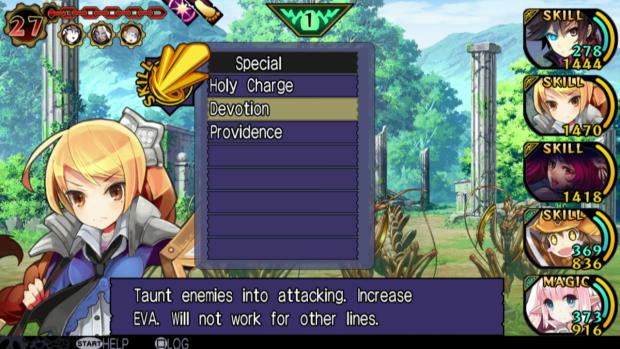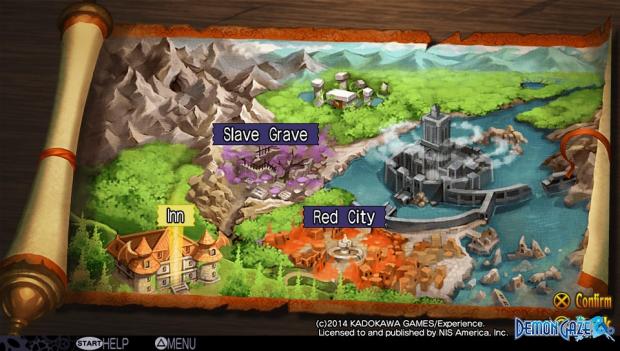Demon Gaze Review
The first-person dungeon crawler is probably one of the oldest sub-groups of the RPG genre, and it’s certainly one of the first reasons role playing games became popular in Japan. So much so that while the genre is all but dead in the West, new games of this type are still rather popular in the East.
Demon Gaze is one of the few Japanese dungeon crawlers to reach our shores, and while its mechanics and portrayal of women are rather archaic, Vita-owning RPG fans who want something a little more hardcore will find plenty to sink their swords into. In fact, the Vita’s portable nature makes a game such as this far more palatable.

After beginning the game and customising your character’s aesthetics and class, you awaken with little memory and quickly find that you are a Demon Gazer. This title is given to those who are given the ability to seal demons’ souls, and are also able to hold a limited amount of dominion over these dark forces. Soon after sealing your first demon, you are taken back to an inn, which is the basic hub for most of the tasks that are required of you.
The slightly capitalist nature of the inn’s owner is swiftly discovered, as each time you leave the inn and return, you are charged a fee for your boarding. But fear not, for this inn happens to be completely inhabited by mercenaries, here to loot the nearby areas of treasures in order to pay their fee, and you are no different. A bulletin board informs you of all manner of quests, from the menial tasks given to you by the inn’s employees, to more dramatic endeavors. Meanwhile, the inn is also home to weapon and item shops that will provide you with useful equipment for your travels, although much better equipment is found out and about. It’s also possible to hire party members to assist you, although you’ll be expected to pay for their room rental as well, increasing the amount of money spent when returning to the inn after a successful day of slaying.

But the meat of the game is, of course, crawling around dungeons. The world you are in is split into six areas, although you won’t have access to every part of every area from the beginning. Played exclusively in first person, you are given an on-screen map that fills in as you explore. You move one step at a time, and while battles are displayed in the environment as large, ugly icons, you’ll also engage in the odd random battle. These aesthetically unpleasing icons also show up for items and Demon Gates, which you’ll need to track down in order to obtain the next powerful demon. You’ll also be able to sacrifice gems to these gates to call forth enemies. Upon defeat, you’ll get some loot and equipment depending on the gems you give up, and the quality of these are random.
Essentially, there’s a lot of going back and forth between the dungeons and the inn in an almost Metroid-like fashion as you find new abilities and items that allow you to explore more of each area. Each demon you find and equip has i’s own abilities, such as being able to display where hidden doors are.

Combat is of the turn-based variety and, much like the rest of the game, its presentation is very bare-bones, consisting of static, albeit beautifully hand-drawn, visuals, with no animation whatsoever. But it’s the game’s use of demons that is a nice idea: although you can summon them at any time, they can only be used for so many turns, as indicated by a demon gauge. Should this gauge run out, you will no longer be able to control the demon, and it will start attacking you in a fit of rage. Thus, you must be sure to keep an eye on the bar to make sure your greatest asset doesn’t become your biggest nightmare.
It’s a pretty tough adventure, although you are able to change the difficulty at any time. From the start, there are plenty of tutorials to talk you through your initial adventures, and there are plenty of features to keep things simple for players new to the genre. Being able to pick a point on the map that you’ve previously visited and auto-walk to that location is rather handy, for a start.

As mentioned early on in this review, Demon Gaze’s biggest problem is its archaic nature. While the Vita’s screen makes the mostly static visuals pop out, the lack of animation really starts to let the game down, much like the cringe-worthy way women are portrayed throughout. As you can expect from a JRPG, the female of the species is portrayed as either weak or in a state of unnecessary undress. It’s the sort of thing that makes playing the game an incredibly uncomfortable experience, and I can’t be the only one tiring of this overplayed trope. Still, this is more a casualty of Japanese culture than a problem that affects just this game. Sexism aside, this is an excellent localisation, with well-written and delivered English dialogue that is a cut above most localisation efforts – although the original Japanese vocal track is present for purists.
VERDICT: This is certainly a game for the role-player who fancies something a little different. While the presentation leaves a lot to be desired, there are plenty of elements that make Demon Gaze a good jumping-off point for the first person dungeon crawler. If you can stand the typically Japanese sexism, you might just enjoy this challenging, if repetitive, adventure.

GOOD. A game that scores 7/10 is worthy of note, but unworthy of fanfare. It does many things well, but only a few of them incredibly well and, despite a handful of good qualities, fresh ideas and solid mechanics, it fails to overwhelm.
Review code provided by publisher.




